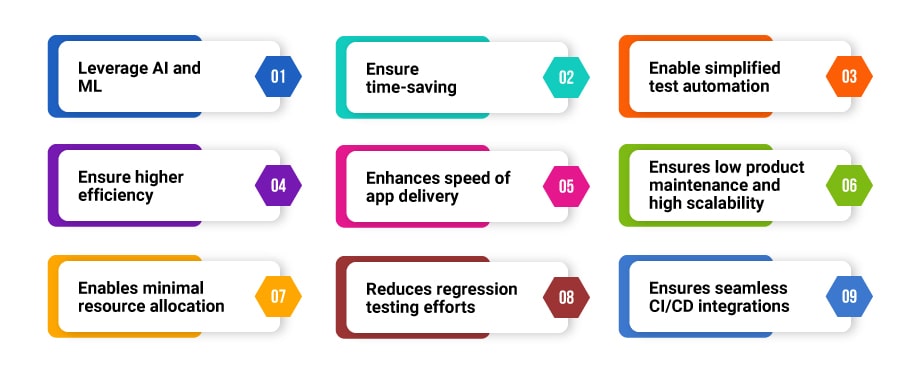Recommended Blogs
The Need for Codeless Test Automation for Digital Enterprises in 2025 and Beyond

Content
- An overview of codeless test automation
- Difference between low-code and codeless test automation
- Why do digital enterprises need codeless test automation in 2025 and beyond?
- How Does Codeless Test Automation Works?
- Top codeless test automation tools in 2025
- Conclusion
- How Tx Can Help You with Your Low-code, Codeless test automation needs
An overview of codeless test automation
The codeless automation trend has gained immense traction in the global digital system. The codeless automation platforms are software programs requiring little to no coding knowledge. Codeless test automation processes enable predesigned templates for workflows with a drag-and-drop interface for simplified customization. This helps business executives with no back-end computer programming knowledge to manage the workflows without any dependency. Codeless test automation platforms are gaining much attention due to the wide range of benefits they offer to digital businesses, such as quicker product releases, process scalability, self-service capability, and so on.
According to GlobeNewswire, the global codeless development platform market is predicted to generate a revenue of $187.0 billion by 2030. The global market is expected to grow at a CAGR of 31.1% during the forecast period 2020-2030.
Difference between low-code and codeless test automation
| Coding Knowledge | Low code is created for Dev teams and needs little coding knowledge. The platform offers a means of automating things faster, but only for people with tangible coding skills | Codeless is designed especially for business executives, and no coding knowledge is needed |
| Automation Process | Low code still relies on some coding for designing automated processes | Codeless platforms allow the end-user to dictate the automation process design through simple drag-and-drop manipulation |
| Dependency on Dev | Low code allows users to handle automation up to a certain point. So, the Dev team or tech-savvy will have to take charge and drive QA automation | Codeless platforms are simplified and give absolute independence to the user since they don’t need any technical knowledge to operate the platform |
| Ease of Customization | It can be completely customized | Only pre-built templates can be used |
Why do digital enterprises need codeless test automation in 2025 and beyond?

Leverage AI and ML:
Codeless automation testing tools integrate AI or ML. The adoption of AI and ML is staggeringly high because these latest technologies combine human intelligence and computer intelligence to accelerate development, reduce errors, and automatically handle processes.
Ensure time-saving:
One of the primary advantages of codeless automation testing is time-saving. As testers don’t have to spend their time coding or learning to code — it is possible to start with codeless testing from day one.
Enable simplified test automation:
When test automation is created through visual UI workflows, the entire code is generated at one place, making QA automation easy to understand and perform. QA teams can automate cases as soon as the app UI is completed.
Ensure higher efficiency:
Codeless test automation enables faster feedback cycles and faster time to market as it reduces software development time. Since tests are executed rapidly in a highly controlled environment, codeless test automation enables higher efficiency.
Enhances speed of app delivery:
One of the best advantages of moving to codeless automation testing is the speed with which DevOps teams manage the app development. Codeless automation testing offers a simplified UI that enables quick learning. Since DevOps teams need not write any code, QA teams can create test cases aided by AI, therefore enhancing both performance and the speed of testing.
Ensures low product maintenance and high scalability:
Codeless test automation makes it possible to automate tests with visual UI workflows which inherently adhere to the current business rules and best practices, hence making the application testing highly scalable and low maintenance
Enables minimal resource allocation:
When testers are not required to spend their time automating their regression tests by creating test cases, they have more time for exploratory application testing. With codeless test automation, there’s no need to involve developers in the creation of UI tests, which is cost-effective.
Reduces regression testing efforts:
Regression testing is time-consuming, and it’s best to automate it. Regression testing being monotonous and repetitive, codeless test automation enables QA engineers to significantly decrease their efforts and focus on other important critical aspects of testing, such as exploratory or acceptance testing.
Ensures seamless CI/CD integrations:
Codeless automation testing tools are significantly advantageous for teams with agile and DevOps cultures. Seamless CI/CD integration ensures all the application updates are done regularly.
How Does Codeless Test Automation Works?
Step 1: Choose the Right Tool
Select an automation tool that suits project needs. It should support the platforms to be tested, provide integration capabilities with existing systems, and be user-friendly.
Step 2: Understand the Application
Before beginning the testing process, thoroughly understand the software application that will undergo testing. This includes familiarizing with its functions, features, and possible user interactions.
Step 3: Identify & Record Test Cases
Identify key test cases that need to be automated. These usually include high-risk areas, repeated test cases, large data sets, and functionalities that have frequent regression errors. Start the ‘Record’ feature with the selected tool and manually perform the test case steps on the software application. Execute each step precisely, as the tool will capture every interaction.
Step 4: Review and Save the Test Script
Once you finish recording, the tool will automatically create a script. Review this script for accuracy and make any necessary adjustments. Then, save this script for future use.
Step 5: Playback the Test
Utilize the ‘Playback’ feature to run the test. The tool will replicate earlier actions exactly, performing the test automatically.
Step 6: Analyze the Results
After completing the test, the tool will generate a detailed report. Review this report to analyze the test results and identify any issues or bugs.
Step 7: Debug and Maintain
The QA engineer can easily update the test script if there are any test issues or application changes. The visual modelling feature of codeless tools makes debugging and maintenance easier.
Step 8: Integrate and Schedule
Integrate the codeless testing tool with your CI/CD pipeline and ALM tools for seamless operations. Schedule tests as needed to ensure consistent quality assurance.
Top codeless test automation tools in 2025

The following are the key areas to look for when choosing the codeless test automation tools in 2025:
• Allows running of the most time-consuming and repetitive QA tasks without any coding knowledge, such as smoke tests and regression tests
• An easy-to-use UI that is straightforward to maintain a test suite with frequent product updates
• Enables testing on multiple OS and browsers
• A scalable tool that adapts to the evolving size and maturity of the team
• A comprehensive solution that enables quick testing with a few clicks
Based on the above criteria, here is the list of recommended codeless test automation tools:
S.no |
Codeless Test Automation Tools |
Key Features |
| 1. | Tricentis TOSCA | • Supports test automation at the UI and API layers, service virtualization, exploratory testing, and the entire SDLC • Supports 160+ technologies with over 90% test automation rates • Provides a safety net of automated unit, code integration, and test management functionalities • Business-focused users can be engaged with the Model-based approach |
| 2. | UiPath | • Planning and monitoring tests for test automation for various applications and environments • Seamlessly connects to the application lifecycle management (ALM) toolchain and integrates with tools like ServiceNow, SAP Solution Manager, and Azure DevOps • Requirements traceability and visual logging for rapid triage of any defects • Veracode certified and integrates into the existing DevOps toolchain • Centralized governance by using a common automation platform and approach |
| 3. | Selenium IDE | • Allows running a particular test or an entire test suite that counts a group of tests. • Setting breakpoints & pausing on exemptions make it simple for debugging testing from the IDE itself. • Used for browser automation testing as cross-browser testing can be implemented using the Selenium SIDE runner. • Supports several commands used to create loops, insert waits, rise asserts, and more |
| 4. | Katalon Studio | • Provides agility by generating test scenarios even before the app gets ready. • Support multiple data sets and parallel implementation. • At once binding to adjust to most app changes. • Flows and Elements can be reusable across scenarios. • CI/CD pipeline and ALM system integrations involving Git, Jenkins, qTest, Jira, CircleCI, etc. |
| 5. | Virtuoso | • Natural Language Programming – write robust and reliable tests in plain English. • ML-driven self-healing – Virtuoso dives into the DOM of applications and builds models of objects from the available selectors, IDs, and attributes – this model is then used to understand if the object has changed. • Combined Functional UI and API capabilities – test both the back- and front-end of applications from a user perspective. • Author before development – Fully executable tests can be written from requirements or wireframes. • CI/CD integration – run tests the second the code is committed. |
| 6. | AccelQ | • Capacity to automate User Interface and API with ease and in a similar flow • Creates app blueprint for great visual test designs • Speedy development and most minor maintenance with Embedded Frameworks • Projecting and Path Analysis traits for generating test scenarios • Maximize test coverage through Data flows and Model UI • Continuous integration-ready and allows in-sprint automation |
Conclusion
Codeless test automation does a great job of enabling business executives to manage automated tests without the knowledge of coding skills. With ongoing technological progress, codeless test automation is evolving steadily. Given the noteworthy benefits mentioned above, we can say that codeless test automation makes application testing straightforward and efficient. Hence, digital businesses should leverage codeless test automation from a professional QA services provider and embed these techniques in their agile workflows to achieve better product development.
How Tx Can Help You with Your Low-code, Codeless test automation needs
• Tx has partnered with Sofy, the leading AI-based codeless quality automation platform.
• Leverage the combination of advanced technologies like AI, ML, RPA, BPM, etc.
• Ensure process and operational efficiency, save time & cost and deliver a great CX
• Profound knowledge and ability to perform scriptless test automation
• Substantial reduction in test design and QA maintenance efforts
Discover more
Stay Updated
Subscribe for more info
